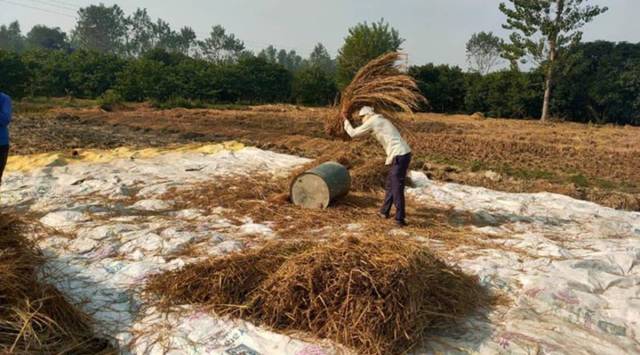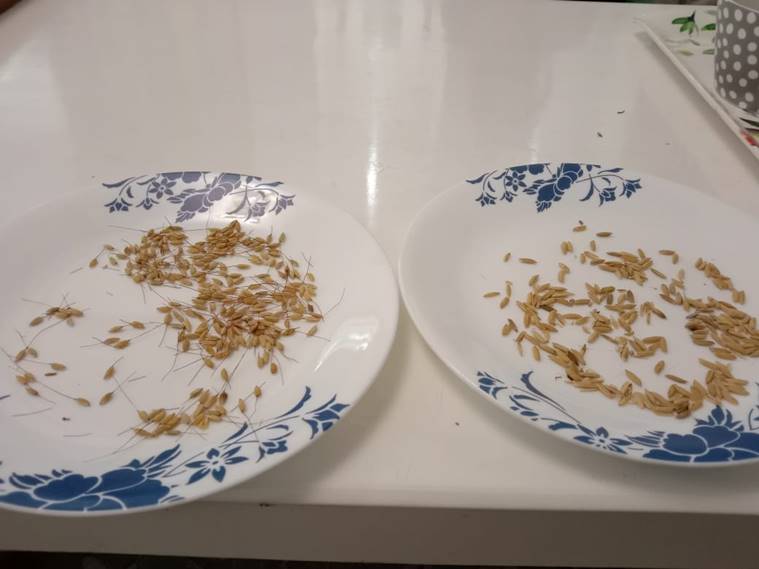- India
- International
Saving tilak chandan’s fragrance: Why a field in Rampur is growing an heirloom rice variety
Many indigenous rice varieties in India were driven to extinction by the Green Revolution. They need to be preserved, for their distinct aroma and flavour, and for their relationship with the environment.
 The tilak chandan being threshed at Benazir Farm in Rampur, in November. (Photo: Twitter/@DrTarana)
The tilak chandan being threshed at Benazir Farm in Rampur, in November. (Photo: Twitter/@DrTarana)India once grew more than 1,00,000 varieties of rice. History and mythology bear proof that rice was served to Gods, kings, and commoners across India’s geographically diverse corners, for millennia. Closer home, ask your grandparents about rice, and they will tell you of different varieties used for different dishes, one known for its fragrance, another considered healthy for pregnant women.
But as the Green Revolution swept through India’s fields in the late 1960s and 70s, it pushed out indigenous rice varieties, focused on high-yield hybrids that could feed our starving millions. With thousands of these varieties, called landraces, near extinction, efforts are now being made to revive them.
One such effort is in progress in Uttar Pradesh’s Rampur, where tilak chandan, a fast-disappearing breed of rice, has been cultivated as part a University of Sheffield project, ‘Forgotten Food: Culinary Memory, Local Heritage and Lost Agricultural Varieties in India’.
Tilak chandan is a thick, small-grained rice known for its fragrance. It is excellent for dishes like kheer and khichdi, where the rice needs to assimilate with the other ingredients.
Tarana Khan, a historian and author based in Rampur who is collaborating with the University of Sheffield for the project, said, “Old-timers in Rampur say when tilak chandan was cooked in one kitchen, the fragrance wafted through the neighbourhood. Today, for various dishes, even if you copy the exact recipe your grandma used, you won’t get the same taste, because the taste of the grain itself has changed. Unless attempts are made to save them, some flavours and aromas will be lost forever, preserved only in the memory of the older generation.”

The memories of such rice varieties are often oral, and the main reason they are not grown anymore is because they are commercially unviable when competing with disease-resistant, high-yield modern varieties.
Threshing Tilak Chandan, the penultimate gathering of the bounty at Benazir farm. It is the first stopover in our journey of resurrecting heritage rice varieties under the aegis of GCRF funded Forgotten Foods project.#heritagerice #rice #forgottenfoods #rampur @s_lamberthurley pic.twitter.com/s9ALXQJjjV
— Dr Tarana H. Khan (@DrTarana) November 25, 2020
According to the university, their partnership with Khan “bridges the gap between culinary memory, local heritage and lost agricultural varieties.”
So how did the collaboration come about, and what exactly are they trying to achieve?
Khan has her roots in Rampur, a small but culturally rich erstwhile princely state. During the Revolt of 1857, Rampur had supported the British, which saved it from the fate of Delhi and Oudh. Thus, artists from both these kingdoms, as well as chefs, flocked to Rampur. Over the years, the royal kitchens also absorbed European influences.
As time erodes this rich heritage, Khan is trying to document Rampur’s history, including its original recipes. This involves digging through cookbooks in Persian and Urdu at Rampur’s famous Raza Library, and also recording oral histories from people who experienced the Nawabi era.
“We came across Khan’s work gathering oral histories in Rampur, which included recollections of these rice varieties, and that is how we ended up engaged in the enterprise of growing tilak chandan,” said Siobhan Lambert-Hurley, professor of Global History at the University of Sheffield, who leads the project.
But the road from idea to harvest was a long one. “Seeds of these varieties are hard to procure. And in the middle of the project, coronavirus hit,” said Khan. “Our original plan was to procure the seeds of hansraj, another rice variety, from Debal Deb, a scientist who maintains two rich seed banks of indigenous rice varieties. However, that was derailed because of the pandemic. I then got in touch with a farmer friend, who managed to find seeds of tilak chandan.”
 One of the ways to differentiate tilak chandan grains (on the left) from other varities is their long shaft. (Express photo: Yashee)
One of the ways to differentiate tilak chandan grains (on the left) from other varities is their long shaft. (Express photo: Yashee)
The farmer, Brinder Singh Sandhu, owner of Benazir Farm in Rampur, sowed the tilak chandan on a small patch of his lands. “I got the seeds from another farmer in Bilaspur (near Rampur). Some farmers cultivate these heirloom varieties on a small scale, for domestic consumption or simply to ensure they aren’t wiped out. While in markets, you can find people claiming to sell tilak chandan, it is often not genuine. It is one of the modern, somewhat fragrant varieties people try to pass off as tilak chandan. Very few farms cultivate the authentic variety,” said Sandhu.
Why are these varieties not grown on a larger scale?
“Tilak chandan can take up to 180 days from transplantation to harvest, while the modern Basmati takes 110 days. Crucially, the yield is about 1/5th, tilak chandan has fewer grains per shaft. Also, the shafts are longer than the modern varieties, which means rain and wind can flatten them more easily. The grains are small and light, which means they weigh less,” Sandhu explained.
The tilak chandan grown in Sandhu’s farm will now be shipped to Sheffield, where attempts will be made to grow the same rice in a lab.
“At Sheffield, historians are working with plant scientists –– specifically, Professor Duncan Cameron and the Institute for Sustainable Food. We will grow the heritage rice varieties in ‘virtual’ rice paddies, which will allow us to recreate the soil, light and climatic conditions of historic Rampur based on archival records from the early twentieth century. Recreating these conditions is important if we hope to mimic as closely as possible the taste, texture and smell of the historic rice varieties. The crop will be used for taste tests and other scientific analysis to ascertain desirable qualities that could be incorporated into high yield, drought resistant strains in future,” said Lambert-Hurley.
The final leg of the project is to host a food festival in Rampur in October 2022, where dishes on offer will include this heritage rice cooked in traditional recipes, and see if it matches the taste preserved in the old-timers’ memory.
 The virtual rice paddy at the University of Sheffield. Tilak chandan will be sown in a similar set-up. (Photo courtesy:
The virtual rice paddy at the University of Sheffield. Tilak chandan will be sown in a similar set-up. (Photo courtesy:Siobhan T Lambert-Hurley)
Forgotten Food is also working on other ways to revive kitchen memories and culture. Historian Rana Safvi, who is a project partner, said: “The project is about tracing the ethos behind cooking in South Asian Muslim homes. It includes food walks and food writing. I, for example, have curated a food walk in New Delhi’s Shahjahanabad, and am writing on details of the dastarkhwan, the prayers said, and the etiquette of food – no waste, can’t make food wait for us, etc.”
However, there is more to this rice than recreating the past.
“It will be great to taste dishes we have heard family elders wax lyrical about,” said Raspal Sandhu, Brinder Singh’s wife. “But we need to save these varieties for reasons other than nostalgia. Any farmer will tell you that the lab-produced rice varieties deplete the water table, degrade soil quality, and need a lot of chemical fertilisers and pesticides. The indigenous breeds are naturally suited to the soil and climate of a particular area, so they don’t require chemical add-ons,” she added.
Agriculture scientists agree. Prof Ranjit Singh Ghuman, of the Centre for Research in Rural and Industrial Development (CRRID), said to ensure agriculture does not take an irreversible toll on the environment, landraces are the way forward. “The Green Revolution was the need of its times. Filling bellies had to be the government’s priority. But the climate cost of that water-and-chemical-intensive agriculture is becoming increasingly obvious. We need urgent government and private support to encourage organic farming and the plantation of indigenous rice.”
Debal Deb, the scientist working to preserve landraces, said both scientists and policymakers in India need to shift their attention from imported hybrids. “First, ‘high-yield’ is semantic imperialism. When a farmer is presented a new seed as a ‘high-yield’ variety, he assumes his native seeds are low-yield. Not all native seeds are low-yield. But most importantly, the modern varieties need optimal conditions. Whereas the landraces can survive in extreme climatic conditions, something we need to be prepared for with the rising global warming and climate change.
 Historian Tarana Khan and farmer Brinder Singh Sandhu in the tilak chandan fields. (Photo courtesy: Tarana Khan)
Historian Tarana Khan and farmer Brinder Singh Sandhu in the tilak chandan fields. (Photo courtesy: Tarana Khan)
At my seed bank, we have rice varieties that can survive on sea water, some that don’t need any water after transplantation. Also, these rice types are more nutrient-rich than the modern ones. To ensure food security and nutrient security in the face of climate change, policymakers and scientists both need to turn their attention to native varieties.”
Khan said she hoped the Rampur food festival could help this cause, at least in her city. “Most people have so far only heard their elders talk of the flavours and fragrances of rice. Maybe if you serve them history on their plate, they will care more about conserving it,” the historian said.
Apr 26: Latest News
- 01
- 02
- 03
- 04
- 05








































